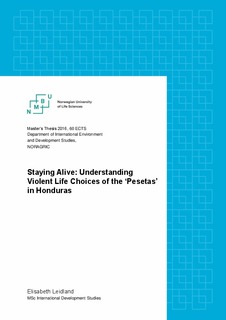| dc.description.abstract | Since the gang culture emerged in Honduras more than two decades ago, the official discourse has hold marginalized youth and gang members responsible for the prevalence of violence in the Honduran society. The portrayal of them as the main perpetrators of violence have led them to become the prime targets of repressive security measures, and ultimately allowed for their lived realities of victimization to be omitted from the official discourse, while the lived realities of the former gang members, the pesetas, have been silenced all together. This thesis goes beyond the general perception and examines the lived realities of marginalized youth, gang members, and pesetas. It shows how they in the course of their lifetime move along a continuum of violence, constantly shifting between being victims and perpetrators of violence.
The study uses the concepts of ‘dehumanization’ and ‘social death’ to show how the structural constraints of having limited opportunities of a worthy life, and not being recognized as fully human affect the marginalized youth’ choice to take a violent life chance. It reveals the interplay between their structural suffering and victimization, and their active choice to resist oppression and to claim a position and a voice in the society.
This study shows that violence is an important characteristic in the construction of subjectivity, and the main mechanism to reclaim a sense of humanness and respect for marginalized youth. Furthermore, it illustrates how joining a gang can be an active choice to stay alive socially and physically by escaping social marginalization and family negligence, in addition to generating a meaningful life. As gang members, however, they are still as much subjected to being victims as perpetrators of violence, and while they are able to reclaim a sense of humanness, they continue to be dehumanized.
Lastly, the study reveals that becoming a peseta is to return to the path of social death
characterized by insecurity, marginality, and exclusion. Even when the pesetas have a desire to change, they are often forced to reenter the violent life as a mean to survive.
The marginalized youth, gang members, and pesetas continuously move between a violent life chance and the social death in a constant struggle to stay alive. | nb_NO |

